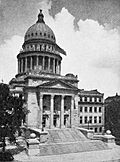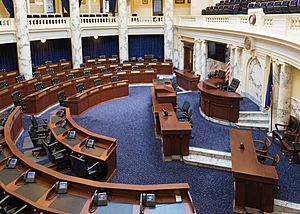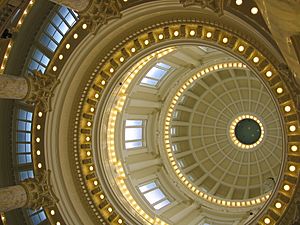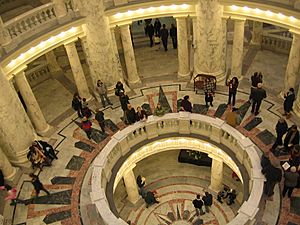Idaho State Capitol facts for kids
Quick facts for kids Idaho State Capitol |
|
|---|---|
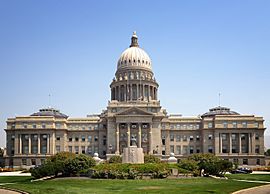
View from southwest in August 2012
|
|
| General information | |
| Architectural style | Classical Revival |
| Location | 700 West Jefferson Street Boise, Idaho, U.S. |
| Coordinates | 43°37′04″N 116°11′59″W / 43.6177°N 116.1996°W |
| Construction started | 1905 |
| Completed | 1912 1920 (wings) |
| Cost | $2,098,455 |
| Owner | State of Idaho |
| Height | 208 feet (63 m) |
| Technical details | |
| Floor area | 201,720 sq ft (4.631 acres; 18,740 m2) |
| Design and construction | |
| Architect | John E. Tourtellotte Charles Hummel |
|
U.S. Historic district
Contributing property |
|
| Part of | Boise Capitol Area District |
| NRHP reference No. | 76000663 |
| Added to NRHP | May 12, 1976 |
The Idaho State Capitol in Boise is where the government of Idaho works. It's like the main office for the state. Before Boise, Lewiston was the capital for a short time, starting in 1863. But on December 24, 1864, the government decided to move the capital to Boise.
Building the Capitol started in 1905. This was 15 years after Idaho became a state. The main architects were John E. Tourtellotte and Charles Hummel. Tourtellotte was from Connecticut and became very famous in Boise. Hummel was an immigrant from Germany who worked with Tourtellotte. The building cost over $2 million and was finished in 1920. The architects used many different materials. They also got ideas from old Classical buildings. The outside of the Capitol is made of sandstone from a quarry near Table Rock.
The building was added to the National Register of Historic Places on May 12, 1976. It is part of the Boise Capitol Area District.
Contents
Building the Idaho Capitol
The architects, Tourtellotte and Hummel, used four kinds of marble. They used red marble from Georgia, gray marble from Alaska, and green marble from Vermont. They also used black marble from Italy. The building's design was inspired by famous buildings. These include St. Peter's Basilica in Rome and St Paul's Cathedral in London. The United States Capitol in Washington, D.C. also gave them ideas.
The most noticeable part of the Capitol is its large dome. On top of the dome is a bronze eagle. This eagle is about 5 feet 7 inches (1.7 meters) tall. The whole Capitol building is 208 feet (63 meters) high. It covers an area of 201,720 square feet (18,740 square meters). Inside, there are over 50,000 square feet (4,645 square meters) of beautifully carved marble.
There are 219 pillars in the original building. These pillars are in different styles: Doric, Corinthian, or Ionic. Each pillar is made from a mix of marble dust, plaster, and scagliola. Scagliola is a special mix that looks like real marble. It was made by a family of artists from Italy.
Inside the Capitol Building
When you look up from the first floor, you can see 13 large stars and 43 smaller stars on the dome. The 13 big stars stand for the original thirteen colonies of the U.S. The 43 smaller stars show that Idaho was the 43rd state to join the country. The floor also has a compass rose. In its center is a sundial made with minerals found in Idaho. On the first floor, you can also see a statue called the Patriot. This statue, made by Kenneth Lonn, honors people who worked in the mining industry.
You can reach the second floor from three entrances: east, south, and west. The office of the lieutenant governor is in the west wing. It is right across from the governor's office. On the north side of the second floor, there is a sculpture of George Washington on a horse. Behind it are the offices of the attorney general. These offices used to be where the Supreme Court met until 1970. The east wing holds the offices of the secretary of state. In their reception area, you can see the official Great Seal of the State of Idaho.
The third floor has the Idaho Senate in the west wing. The Idaho House of Representatives is in the east wing. Both of these rooms were updated in 1968. This floor also has many old paintings. There are also three large murals by Dana Boussard.
Restoring the Capitol Building
In 1998, Idaho officials made a plan to restore the Capitol. The building was getting old and needed repairs. The plan included fixing windows, marble floors, and plaster. They also planned to restore wood floors and doors. They wanted to upgrade the electrical and fire safety systems. New exterior lighting and an emergency power generator were also part of the plan. An elevator for people with disabilities was also added.
At first, the government only gave $120,000 for the project. In 2000, the full plan was ready. It was estimated to cost $64 million. In 2001, the Legislature gave $32 million. The rest of the money came from bonds. From 2002 to 2003, workers finished the second part of the project. This involved fixing the outside of the building. In 2005, an increase in the state cigarette tax helped pay for interior repairs, costing $20 million.
In 2006, the Legislature decided to build two underground office wings. These would be two stories deep and cost about $130 million. However, because of money problems in 2008, Governor Butch Otter suggested smaller, one-story underground wings. Lawmakers agreed, and construction started. The renovations, both inside and out, were finished in 2010.
Scagliola Art in the Capitol
Workers had to restore the scagliola in the Capitol. Scagliola is a special material made of selenite, glue, and colors. It is designed to look like marble or other stones. Making scagliola is a very hard process with 15 steps. If one mistake is made, they have to start over. The architects wanted the Capitol to be a "Capitol of Light." They used white marble and matching scagliola. These materials would glow in the natural light in the rotunda.
Capitol Artworks
The Winged Victory statue is a plaster copy of the original marble statue. The original is called Nike of Samothrace. It was found in Greece in 1863. This statue shows the style of Hellenistic art. The people of France gave this copy to the United States. It was a gift after U.S. forces helped free France in World War II. The statue arrived in February 1949 and was placed in the Boise Capitol.
The sculpture Statue head of Louise Shadduck honors Louise Shadduck. She was an Idaho author, historian, and political activist. She passed away in 2008 at age 92. In 1958, Shadduck became the first woman to be elected Secretary of Commerce and Development. This statue is made of bronze and black stone.
The Capitol also has 20 portraits of Idaho's governors. These were painted by artist Herbert A. Collins in 1911.
Things to See at the Capitol
Attractions in the restored building include a golden statue of George Washington on a horse. You can also learn about the historic trees that used to be around the Capitol. Three U.S. Presidents planted trees there. Benjamin Harrison planted a Water Oak. Theodore Roosevelt planted a Sugar Maple in 1903. William Howard Taft planted an Ohio Buckeye in 1911. The Golden Statue was carved by Charles Osner in 1869. It is made from white pine, which is Idaho's state tree. Osner worked by candlelight and took four years to finish it.
More About the Capitol
Tunnels connect the Capitol Building to the Idaho Supreme Court building. They also connect to other government buildings on Capitol Mall. Government workers use these tunnels every day. They are not open to the public. These tunnels could also be used as bomb shelters to protect officials.
A full-size copy of the Liberty Bell is outside the Jefferson Street entrance. This bell is one of 53 copies made in 1950 by the U.S. Treasury Department. Each state received one. Visitors can ring this bell.
The Capitol faces southwest and looks down Capitol Boulevard. This street is about one mile (1.6 km) long. At the other end of the street is the Boise Union Pacific Depot, a train station built in 1925.
See also
 In Spanish: Capitolio del Estado de Idaho para niños
In Spanish: Capitolio del Estado de Idaho para niños


